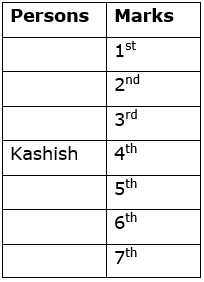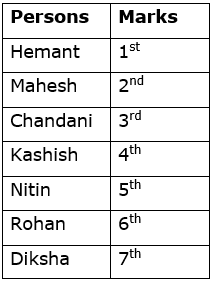Solutions
Persons: Chandani, Diksha, Hemant, Kashish, Mahesh, Nitin and Rohan
1) The number of persons who scored more marks than Kashish is same as the number of persons who scored less marks than Kashish.
So, Kashish scored fourth highest marks.

2) Kashish scored the same marks as the average of the marks scored by Chandani and Diksha where Chandani scored more marks than Diksha. Chandani scored less marks than Mahesh.
So, Mahesh > Chandani > Kashish > Diksha.
3) Both Mahesh and Nitin scored less marks than Hemant but more than Rohan and the marks scored by Rohan is not the least.
So, Hemant > Mahesh > Chandani > Kashish > Diksha and Nitin scored more marks than Rohan and the marks scored by Rohan is not the least.
Thus, Hemant > Mahesh > Chandani > Kashish > Nitin > Rohan >Diksha.

Hence, only Rohan scored between the scores of Nitin and Diksha.



 Get latest Exam Updates
Get latest Exam Updates 





 ×
×






